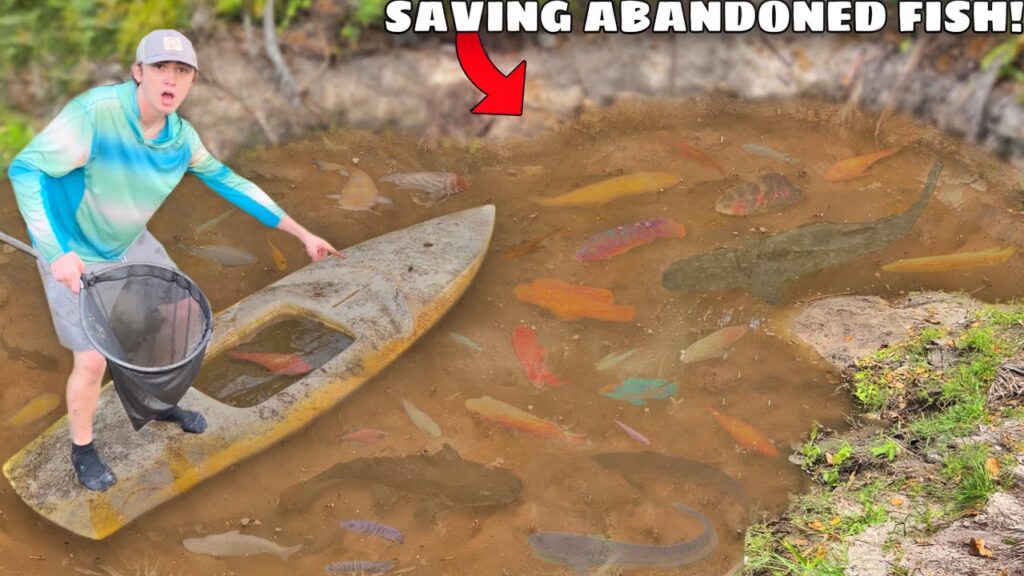In today’s video by Bass fishing Productions, Rob takes on the challenging task of rescuing abandoned aquarium fish from a flooded mud pond. With the water level in the pond significantly high, it becomes crucial to save the numerous fish trapped in it. Using fish traps and nets, Rob successfully catches a variety of fish, including African cichlids, albino oscars, catfish, and monster snakeheads, among others. With a passion for aquatic activities, Rob brings these rescued fish back to his backyard ponds, ensuring their safety and well-being.
The video captures the urgency and excitement of the rescue mission, as Rob navigates through the flooded pond, encountering various species of fish. The flooded pond, a result of heavy rainfall, used to be part of someone’s house, comprising four ponds stocked with aquarium fish. Rob’s determination to save these stranded fish is evident as he describes the process of catching and transferring them to a safer environment. By showcasing the incredible diversity of fish and the challenges faced during the rescue, Bass fishing Productions provides an engaging and educational experience for viewers.

Discovering the Flooded Mud Pond
Table of Contents
The video starts with the presenter, Rob, returning to a flooded abandoned mud pond to save the fish trapped within it. The water levels in the pond are significantly high, posing a threat to the fish’s survival. Rob and his team use fish traps and nets to catch as many fish as possible. The variety of fish they rescue include African cichlids, albino oscars, catfish, and monster snakeheads. The rescued fish are brought back to Rob’s backyard ponds for safekeeping.
Recognizing the Types of Abandoned Aquarium Fish
As Rob and his team explore the flooded mud pond, they come across various types of abandoned aquarium fish. They spot bluegills and tilapia, which are commonly found in freshwater ponds. Additionally, they identify African cichlids, colorful and vibrant fish known for their unique patterns. They also come across convict fish, which are small and striped in appearance. The team also mentions locating larger predator fish like monster snakeheads and bass in the pond.
Gearing up for the Rescue Operation
Before embarking on the rescue operation, Rob and his team gather the necessary equipment. They ensure they have fish traps and nets to effectively catch the trapped fish. Additionally, they prioritize personal safety by wearing appropriate gear and footwear suitable for the muddy and potentially hazardous environment. They also consider the environmental factors that may impact the success of the rescue operation, such as water temperature and weather conditions.
Using Fish Traps and Nets
To maximize their success in catching the trapped fish, Rob and his team design fish traps for optimal results. They strategically place the traps in areas where they have spotted fish activity. In addition to fish traps, they also deploy nets to catch larger fish that may be more difficult to catch with traps alone. They carefully analyze the effectiveness of using fish traps versus nets to ensure they can efficiently rescue as many fish as possible.
First Round of Fishing
During the first round of fishing, Rob and his team attempt to catch the trapped fish using the fish traps and nets. They encounter unexpected challenges, such as the size of the holes in the nets being too big, allowing some fish to escape. However, they manage to catch a significant number of fish and handle them with care. Despite the challenges faced, they remain determined to save as many fish as possible.
Encountering Larger Fish
As Rob explores the flooded mud pond further, he encounters larger fish that pose a greater challenge to catch. He comes across an unusually large snakehead, a predatory fish known for its aggressive behavior. To capture the elusive bass, Rob and his team put in extra effort, as it continuously evades their attempts. They discuss the potential dangers these larger fish pose, emphasizing the importance of careful and cautious handling.
Navigation Through the Drained Pond
In order to continue rescuing fish, Rob and his team decide to initiate a draining operation of the flooded mud pond. This allows them better visibility and access to the fish trapped within it. As the water levels decrease, they spot abandoned fish in the drained pond, reaffirming their commitment to save as many fish as possible. They prepare for future attempts to rescue more fish from the drained pond once the water levels are further reduced.
Relocating Rescued Fish
Once the first round of fishing is completed, Rob and his team focus on the secure transport of the rescued fish. They carefully place the fish into containers or coolers to ensure their safety during transportation. Upon reaching Rob’s backyard ponds, they release the rescued fish into the new environment. This step marks a successful relocation of the saved fish and offers them a chance to thrive in a more suitable habitat.
Future Plans for the Rescued Fish
To ensure the well-being of the rescued fish, Rob proposes a sustainable ecological cycle for their management. He plans to maintain and care for the backyard ponds where the fish have been placed. This involves regular monitoring, feeding, and maintenance to create a healthy and balanced ecosystem. Additionally, Rob discusses a blueprint for managing a possible overpopulation scenario, highlighting the importance of responsible fishkeeping practices.
Conclusion
Rob reflects on the rescue operation, emphasizing the lessons learned from the endeavor. He expresses his personal feelings towards the fish saved, knowing that their lives have been given a second chance. He encourages viewers to help in similar situations and raises awareness about the importance of responsible fishkeeping and conservation efforts. The article ends with a call to action, urging readers to make a positive impact on aquatic life and their habitats.
